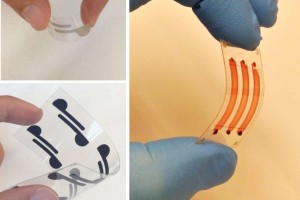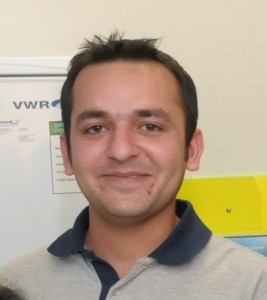Researchers at Florida Atlantic University believe this technology could also be used to detect bacteria in food and water and to follow patients’ progress after leaving acute or outpatient care
New technology could shift the paradigm in infectious disease testing by clinical laboratories, while also giving hospitals a faster way to identify hospital-acquired infections (HAIs) and monitor patients for infections post-discharge. The diagnostic technology is built into a special “biosensing film” made of cellulose paper and a flexible polymer.
Researchers at Florida Atlantic University (FAU) developed the biosensing film. They say it can detect and discern HIV, Staphylococcus aureus, E-coli and other bacteria in blood, plasma, and saliva. The test is inexpensive, disposable, and portable. Best of all (at least for developing countries, remote locations, and places that have few resources), it requires no expensive infrastructure or a clinical laboratory.
And yes, the biosensing film is designed to work in tandem with a smartphone app. But in this case, the mobile app is only part of the story. The real genius is the piece of lightweight, flexible, “electronic paper” or “biosensing film” used with the app. The film acts as a platform that detects infections, both viral and bacterial.
The story of this inventive biosensing film is detailed in a Scientific Reports article in the March 5, 2015, edition of Nature.

This biosensing film is made from cellulose paper and flexible polymer. (Photo copyright Popular Science.)
Biosensing Film Joins Other Diagnostic Tools in the Do-It-Yourself Category
The development of biosensing film appears to be just one example of the growing trend that is bringing forth inexpensive diagnostics for use by those with little medical training in the home, the field, Third World settings, and remote points-of-care. The tests also are designed for places with low-tech capability, less-educated medical personnel, and no clinical laboratory, pathologists, or medical staff.
Other such point-of-care diagnostic test devices include the home pregnancy test, glucometers, point-of-care anemia tests, and lactic acid monitors.

“There is a dire need for robust, portable, disposable and inexpensive biosensing platforms for clinical care, especially in developing countries with limited resources,” stated Waseem Asghar Ph.D., assistant professor of electrical engineering in FAU’s College of Engineering and Computer Science and co-first author of the study, in a university press release. (Photo copyright University of Tennessee Arlington Nano Bio Lab.)
How the New Platform Works and Why It’s Better
The patient provides a drop of blood from a fingerstick and places it on the biosensing film, which is made of cellulose paper and flexible polymer. Each unit is designed to “detect a particular type of bacteria or virus,” according to information released by FAU. If the particular type of cell is present, “nano-particles aggregate around it, dyeing the cells a bluish color to stand out from the rest of the sample.”
The patient or caregiver can then take a “cell-fie” using the camera on the smartphone or tablet. The app will send the image to the medical provider who can make a diagnosis.
Current diagnostic assays and medical laboratory tests require long assay time, sophisticated infrastructure, and expensive reagents, say the researchers. None of these are compatible with settings that are remote or lack resources, infrastructure, and medically knowledgeable workers.
How Researchers Solved Former Problems
Paper-based point-of-care diagnostic tests and portable DNA detectors already exist. However, they remain complicated and expensive to manufacture. The more practical solution, FAU scientists hypothesized, was to use silver nanowire ink. It is highly conductive and stable. But they needed to develop a way to print it on the paper so that it could respond to touch or specific molecules.
They eventually accomplished this by using three different papers and flexible material-based platforms that “incorporated electrical and optical sensing modalities.” By integrating the papers and flexible polyester films, they created a product that can detect bioagents in whole blood, serum, and peritoneal fluid.
Infection Detection in Humans Not the Only Capability
Researchers say that the biosensing platform can isolate and detect multiple biotargets “selectively, sensitively, and repeatedly from diverse biological mediums using antibodies.” The ease of manufacture and affordability means that there are other applications for the invention: detecting bacteria in food and water to help prevent food-borne and water-borne illnesses, drug development, environmental monitoring, and veterinary medicine.
Cheap Paper is the Key
So-called paper electronic sensors have been hailed as the future of inexpensive medical tools, from robots to clinical diagnostics. That’s because paper is cheap, Anming Hu, Ph.D., assistant professor at University of Tennessee Knoxville and an expert in printable electronics, told American Chemical Society News. It makes an “excellent surface for lightweight, foldable electronics that could be made and used nearly everywhere.”
Essentially, researchers developed a low cost cellulose/plastic matrix to hold the reagents that will react to specific types of bacteria or viruses. A cell phone camera then can be used to capture the result of the test and transmit it to a physician or a lab specialist for interpretation.
Yes, this is a project intended for use in developing countries. But as it proves to be viable, clinically reliable and cheap to use, it would not be a big leap for developed nations to utilize this technology for patient self testing—particularly where physicians may have discharged a patient from the hospital and want to watch to see that the patient does not develop specific types of infections.
—E’Louise Ondash
Related Information:
Paper and Flexible Substrates as Materials for Biosensing Platforms to Detect Multiple Biotargets
Biosensing Films and Smartphones Let Doctors Diagnose Disease From Anywhere
New Biosensing Platform Could Quickly and Accurately Diagnose Disease and Monitor Treatment Remotely



